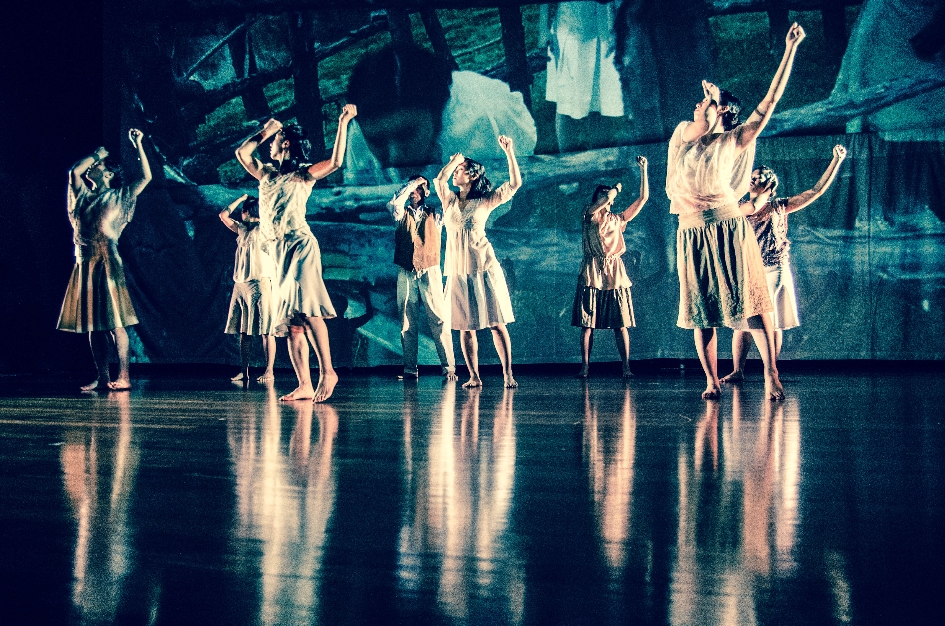Cultural History Meets Multimedia: Stories of Chinese Women Immigrants

In dancer and choreographer Lenora Lee’s new companion works, The Escape and Rescued Memories: New York Stories, she uses multimedia such as voiceovers and video to tell the stories of human trafficking of Chinese women in the early twentieth century.
The works premiered in November at San Francisco’s de Young Museum, where Lee, a native of San Francisco, has been an Artist Fellow for the past year. As a child, Lee attended youth groups and summer programs at the Donaldina Cameron House, a Chinatown community service organization founded in 1874. The Cameron House helped women who were being exploited, and for the last several years, Lee has gone through its archives looking for material for The Escape. The Escape has a cast of 20, including dragon dancers and martial artists, to tell the story of a young girl who is sold, brought to the U.S., and forced into prostitution. Some dancers play the roles of community members at the Cameron House.
“I wanted to do research about what these women had to go through and learn their stories,” Lee said. “I was reading firsthand accounts of what they went through, and it became clear to me this was really modern-day slavery.”
Rescued Memories: New York Stories also deals with human trafficking, in this case telling the story of Bessie Lee, who was brought to New York by a wealthy Chinese couple and ran away when they didn’t pay her. For this piece, Lee went to New York’s Chinatown to shoot video and talked with Bessie Lee’s grandson, the director of the New York Asian Women’s Center. Lee did further research into present-day trafficking, connecting with various shelters and organizations that provide services to these women in San Francisco as well as New York. She hopes to bring awareness to what could be going on with women cooking in restaurants or cleaning rooms in hotels.
“A lot of what Lenora is doing captures how many things are different, but the same,” said Cindy Liou, an attorney with Asian Pacific Islander Legal Outreach, who coordinates the Human Trafficking Project at the San Francisco agency. “Immigrant women suffer disproportionately when it comes to work opportunities.”
In her pieces, Lee shows the complexity of the situation, Liou says.
“People tend to think there’s this dichotomy where someone is either this perfect victim and totally innocent or a bad person because they might have had something to do with prostitution,” Liou said. “There’s this idea that everyone needs to be rescued or that this isn’t an old problem. This is not about rescue—this is tied to a system.”
Presenting a subject like human trafficking through dance makes it more visceral, Liou says. “To have someone visually display what people are going through is very powerful,” she said. “As an attorney, I use a lot of words, and sometimes people don’t want to hear your words.”
Genny Lim, a poet and playwright in San Francisco, has worked with Lee on several of her pieces, including these two latest ones, writing text that is used in voiceovers or projected on the walls. Lim says she loves working on interdisciplinary projects. “They’re so open for creativity,” she said. “I’m principally a poet, and dance is a form of poetry, so I love writing for dance.”
Lim says Lee’s work with so many other artists and community organizations is notable. Lee has worked with various groups on the video shoots, for example, and many of the organizations with which she has partnered, such as Asian Pacific Islander Legal Outreach, have given her contacts as well as spreading the word about the projects.
“What’s remarkable is her connections with community people and her wide support,” Lim said. “I don’t know of any other artist doing that in Asian American communities at such a high artistic level.”
Lin believes that knowing these stories particularly affects the younger generation. “Their cultural histories were shaped by people before them,” she said.
Liou agrees. “History matters in the work we do,” she said. “The narratives of people who are marginalized and exploited are important, and these issues are here and present.”
At the de Young, Lee has given presentations and had panel discussions about the projects, bringing in advocates who provide support services for current-day survivors of human trafficking. The issue is widespread, she says, and she has heard from audience members that they or people they know have had this kind of violence inflicted on them.
Lee’s work lets people identify with what these women have had to go through, Liou says—the psychological oppression and manipulation involved in trafficking as well as the physical.
Lee says that’s what she wants her audiences to understand. “What I try to bring out in the stories are the emotional and psychological repercussions of having to endure this type of experience,” she said. “There’s a lot of psychological brainwashing with women who are brought over and isolated and threatened so they’re too afraid to seek help. I’m trying to shed light on what those experiences are.”
More articles by Category: Arts and culture
More articles by Tag: Trafficking



























